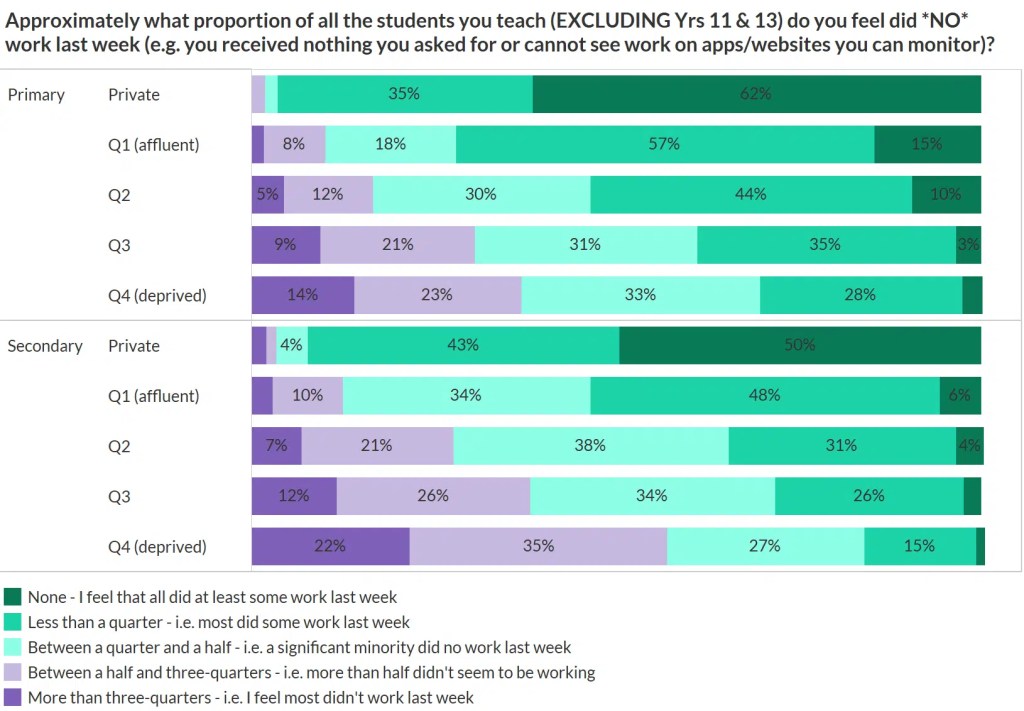1. Would teachers take a furlough?
Furlough hasn’t been available to teachers in the public sector, but this week we learnt that one-third of you would take it if given the chance. But which third? Private school teachers were most likely to want to be furloughed. We know from previous questions that these teachers are working longer hours and doing more live-streamed lessons than teachers in the state sector.

Teachers with very young children are also more likely to want to be furloughed (40% versus 28% among those who have no children). For them, work must be to close-to-impossible at the moment. Yesterday, several teachers in this situation noted on social media the impossibility of trying to share laptops, teach from home, and simultaneously care for toddlers and young children. If these teachers are also currently avoiding childcare costs, then they will be able to afford the pay cut.

Back in January, we asked whether your household could live comfortably within its means. Are teachers who said they were comfortable more likely to want to be furloughed? Yes, but only just.

The results signal how difficult the current situation is for teachers who are trying to work while also delivering childcare and who don’t have the option afforded to employees in many other sectors of taking a furloughed break.
2. What resources are teachers using?
There are increasing grumbles in the media about the level of work being supplied by some schools. Labour politician Andrew Adonis was particularly scathing last week about what he saw as a lack of online learning from schools, but then Talk Radio host Julia Hartley-Brewer has been moaning about schools who are telling parents to “just download” things. What is a teacher to do?
We thought that resource use might change as teachers settled into the new term, and with the addition of BBC Bitesize and National Oak Academy. Things seem fairly static, however, with around half of primary schools using online apps and BBC Bitesize for their online learning, and around half of secondary schools using online education sites that don’t require any subscriptions. Overall, there is still a focus on teachers creating tasks for students – which can be delivered as worksheets, or via online classroom portals – and video content is staying steady at around 25%.

Also there is little change on what teachers did last Tuesday, compared to the Tuesday two weeks earlier – again signalling that what schools are delivering now is what they expect to continue providing. There remains a huge difference in terms of online streaming between state and private schools. Note the level of parent interaction is similar between state and private schools, but the level of personal video/phone calling to students is very different between the two sectors.

A big part of the phone calls to parents is being done by senior leaders and headteachers – with 53% of primary headteachers having called parents on the day we asked.
3. Are kids doing work…?
A problem of distance-learning is that it relies on pupils showing up in some way online (or posting workbooks) for their learning to be recognised by teachers. Anyone who ever tried to get a full set of homework from a class of Year 8s will know this is a challenge!
How many pupils are currently falling through the cracks and teachers are seeing no work from? In the most disadvantaged areas, 1-in-5 secondary school teachers feel the vast majority of their pupils (more than 75%) are doing no work. In the poorest primary schools, the same is true of 1-in-7 teachers. On the upside, state school teachers in the most affluent areas were generally positive that most pupils were doing at least some work.

Is there a subject and age effect? Yes. English and language teachers most struggled to receive completed work. In previous weeks we’ve noted that English is less well-served than Maths and Science by digital platforms which deliver personalised learning in easy ways. However, this is also true of humanities, which seems to be finding things easier, and not true for modern languages (for which online resources are available). Yet, the return rates for this subject are lower.
Sadly, yet predictably, we also see work return rates are lower in the special and AP sector. The reasons for this are complex but it may show a lower level of school engagement for those in AP, and the need for more specialised teaching skills required for children with special educational needs to access work.

4. Who should return to school?
Last night the government announced that schools will not reopen in any way before June 1st. After that time, Year R, 1 and 6 may return in primary school, if it is possible, and there is an “ambition” for Year 10 and 12 pupils to have “some time with their teachers” before the end of the year.
Last week we asked which option you would prefer for who should go back to schools first:
(a) Children in families with the greatest social and economic need – PURPLE
(b) Try to ensure everyone returns part-time (e.g. one day a week) – BLUE
(c) Priority return to certain year groups (e.g. Year 10, 12 and 6) – GREEN
For secondary teachers, the government announcement accords with the choice of 60% of teachers – who felt priority year groups ought to come back first.
Primary teachers, however, were more in favour of everyone coming back for part of the week – so they may be disappointed by the Year R, 1 and 6 approach.
Note that teachers special/AP schools felt that priority should go to parents with the greatest social and economic need.

More information is due from the government this afternoon on the new guidance.





